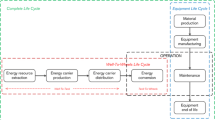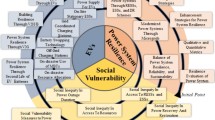Abstract
Based on a system dynamics (SD) model of long-term cost-effectiveness of power pole maintenance over 50 years, the influence of factors that affect cost-effectiveness was examined. Taking a typical region subjected to hurricanes (i.e., Miami-Dade County, USA) as a case, the SD model was established and tested with scenarios of power poles maintenance strategies. Factors such as wind speed variation (due to climate change), regional annual growth rate of the pole population, and discount rate were explored. It was shown that changing the parameters for these factors results in the following: The variation of wind speed due to climate change produces a negative impact on cost-effectiveness under the given replacement strategy; the factors of wind speed and annual growth rate of poles have a significant influence on the replacement ratio of poles particularly in the later period such as later 30 years; similarly, the discount rate has a marked impact on cumulative cost in the later decades. The difference between the contribution of factors is more significant in the later stages of the design life. The simulation results indicate how the change of these factors can lead to an impact on cost-effectiveness over time. The results have meaningful strategy implications, allowing an optimization of the timing of maintenance and a focus on different critical factors at various time periods.













Similar content being viewed by others
References
AGO (2007) An assessment of the need to adopt buildings for the unavoidable consequences of climate change. Final report, Australian Greenhouse Office, Commonwealth of Australia
Bjarnadottir S, Li Y, Stewart MG (2011) A probabilistic-based framework for impact and adaptation assessment of climate change on hurricane damage risks and costs. Struct Saf 33:173–185
Bjarnadottir S, Li Y, Stewart MG (2013a) Risk-based economic assessment of mitigation strategies for power distribution poles subjected to hurricanes. J Struct Infrastruct Eng. doi:10.1061/(ASCE)IS.1943-555X
Bjarnadottir S, Li Y, Stewart MG (2013b) Hurricane risk assessment of power distribution poles considering impacts of a changing climate. J Infrastruct Syst 19(1):12–24
Boswell MR, Robert ED, Richard AS, Jay EB (1999) A quantitative method for estimating probable public costs of hurricanes. Environ Manag 23(3):359–372
Butera R (2000) Asset management for the distribution pole plant-closing the performance gap between traditional maintenance and asset management. IEEE Power Eng Soc Summer Meet 1:561–565
Confalonieri R, Bellocchi G, Bregaglio S, Donatelli M, Acutis M (2010) Comparison of sensitivity analysis techniques: a case study with the rice model WARM. Ecol Model 221(16):1897–1906
Florida Power & Light Company (FP&LC) (2006) Technical report: post hurricane Wilma engineering analysis. KEMA, Miami
Forrester JW (1961) Industrial dynamics. Pegasus Communications, Waltham, MA
Guikema SD, Quiring SM, Han SR (2010) Prestorm estimation of hurricane damage to electric power distribution systems. Risk Anal 30(12):1744–1752
Han SR, Guikema SD, Quiring SM, Lee KH, Rosowsky D, Davidson RA (2009) Estimating the spatial distribution of power outages during hurricanes in the Gulf coast region. Reliab Eng Syst Saf 94:199–210
Jason S (2012) Cause for concern: the 7 most alarming Hurricane Sandy images. Washington Post. http://www.washingtonpost.com/blogs/capital-weather-gang/post/cause-for-concern-the-7-most-alarming-hurricane-sandy-images/2012/10/28/615bbbfe-210b-11e2-ac85-e669876c6a24_blog.html2012-10-28
Johnson B (2005) After the disaster: utility restoration cost recovery. Edison Electricity Institute, Washington, DC
Li Y, Ellingwood BR (2006) Hurricane damage to residential construction in the US: importance of uncertainty modeling in risk assessment. Eng Struct 28:1009–1017
Pryor SC, Barthelmie RJ, Takle GS (2009) Wind speed trends over the contiguous USA. In: IOP conference series: earth and environmental science
Pryor SC, Barthelmie RJ, Schoof JT (2012) Past and future wind climates over the contiguous USA based on the North American regional climate change assessment program model suite. J Geophys Res 117(D19). doi:10.1029/2012JD017449
Reed DA, Powell MD, Westerman JM (2010) Energy infrastructure damage analysis for hurricane Rita. Nat Hazards Rev 11:102–109
Roliadi H, Hse CY, Choong ET, Shupe TF (2000) Decay resistance of out-of-service utility poles as related to the distribution of residual creosote content. For Prod J 17:149–159
Ross PJ (1988) In Taguchi techniques for quality engineering: loss function, orthogonal experiments, parameter and tolerance design. McGraw-Hill, New York
Schwartz N (2011) Violent wind storm leaves path of destruction. http://www.businessweek.com/2013-3-13
Stanley AC, David C (2009) Assessment of a method used to time adjust past storm losses. Nat Hazards 50:5–12
Steenbergen RDJM, Koster T, Geurts CPW (2012) The effect of climate change and natural variability on wind loading values for buildings. Build Environ 55:178–186
Sterman JD (2000) Business dynamics: systems thinking and modeling for a complex world. Irwin, Boston
Stewart MG, Li Y (2010) Methodologies for economic impact and adaptation assessment of cyclone damage risks due to climate change. Aust J Struct Eng 10(2):121–135
Stewart MG, Rosowsky DV, Huang Z (2003) Hurricane risks and economic viability of strengthened construction. Nat Hazards Rev 4:12–19
Tian J, Li Y (2014) System dynamics assessment of mitigation strategies for power distribution poles subjected to hurricanes. Nat Hazard 70(2):1263–1285
Tong C (2010) Self-validated variance-based methods for sensitivity analysis of model outputs. Reliab Eng Syst Saf 95(3):301–309
UKCP09 (2010) Probabilistic projections of wind speed In: Sexton DMH, Murphy J (eds). Met Office Hadley Centre
van den Hurk B, Tank AK, Lenderink G, van Ulden A, van Oldenborgh GJ et al (2006) KNMI climate change scenarios 2006 for the Netherlands. KNMI, De Bilt, report WR 2006-01
Vickery PJ, Skerlj PF, Twisdale LA (2000) Simulation of hurricane risk in the US using empirical track model. J Struct Eng 126:1222–1237
Vickery PJ, Wadhera D, TwisdaleJr LA, Lavelle FM (2009) US hurricane wind speed risk and uncertainty. J Struct Eng 135:301–320
Wen YK (2001) Minimum lifecycle cost design under multiple hazards. Reliab Eng Syst Saf 73:223–231
Acknowledgments
The research described in this paper was supported, in part, by the National Science Foundation (NSF) Catalyzing New International Collaborations Program, and Infrastructure Management and Extreme Events Program under Grant No. NSF-1050443. This support is gratefully acknowledged. However, the writers take sole responsibility for the views expressed in this paper, which may not represent the position of the NSF or their respective institutions. The authors would like to thank Dr. Sigridur Bjarnadottir for providing suggestions and fragility data of distribution poles for this research and also thank Professor William M. Bulleit for his valuable comments and suggestions on this paper.
Author information
Authors and Affiliations
Corresponding author
Rights and permissions
About this article
Cite this article
Tian, J., Li, Y. Factors influencing cost-effectiveness of maintenance of power distribution poles subjected to hurricanes: a system-dynamics-based analysis. Nat Hazards 72, 633–650 (2014). https://doi.org/10.1007/s11069-013-1023-1
Received:
Accepted:
Published:
Issue Date:
DOI: https://doi.org/10.1007/s11069-013-1023-1




